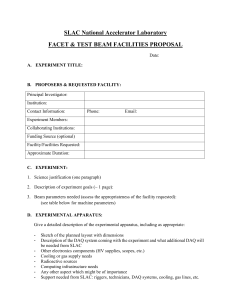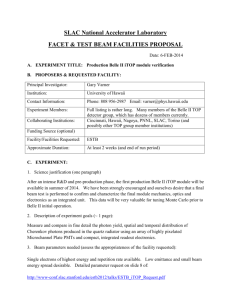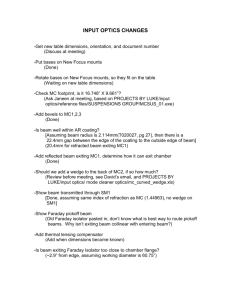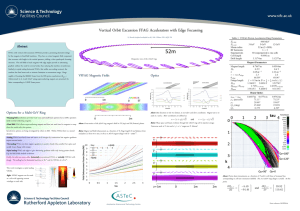The Interaction Region Working Group
advertisement
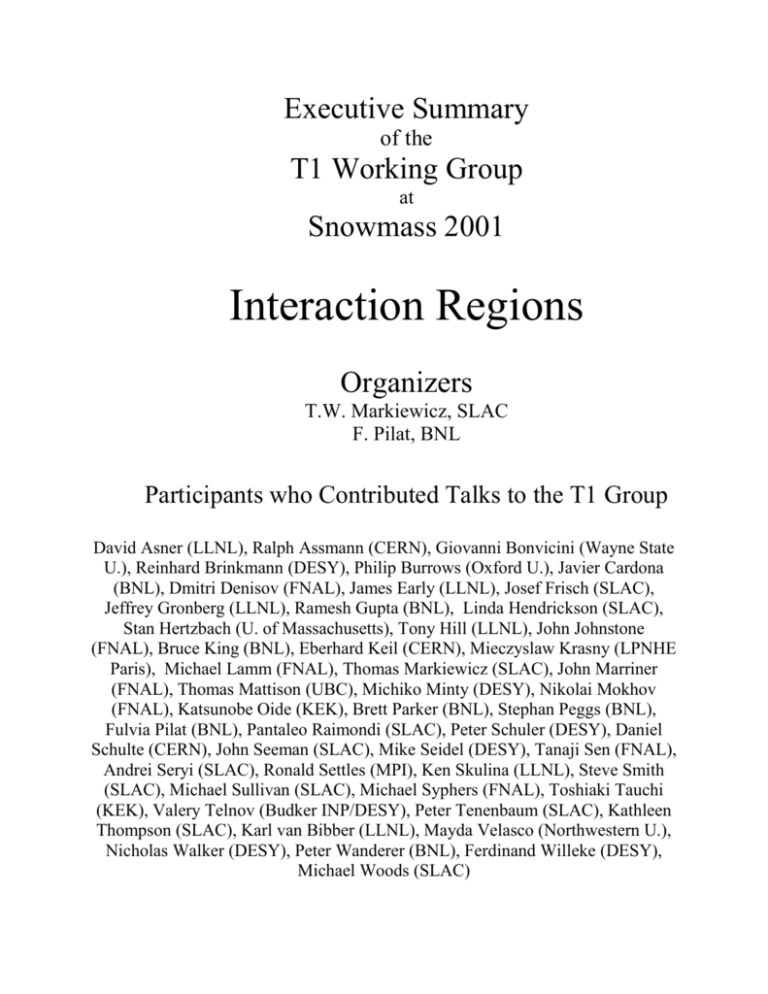
Executive Summary of the T1 Working Group at Snowmass 2001 Interaction Regions Organizers T.W. Markiewicz, SLAC F. Pilat, BNL Participants who Contributed Talks to the T1 Group David Asner (LLNL), Ralph Assmann (CERN), Giovanni Bonvicini (Wayne State U.), Reinhard Brinkmann (DESY), Philip Burrows (Oxford U.), Javier Cardona (BNL), Dmitri Denisov (FNAL), James Early (LLNL), Josef Frisch (SLAC), Jeffrey Gronberg (LLNL), Ramesh Gupta (BNL), Linda Hendrickson (SLAC), Stan Hertzbach (U. of Massachusetts), Tony Hill (LLNL), John Johnstone (FNAL), Bruce King (BNL), Eberhard Keil (CERN), Mieczyslaw Krasny (LPNHE Paris), Michael Lamm (FNAL), Thomas Markiewicz (SLAC), John Marriner (FNAL), Thomas Mattison (UBC), Michiko Minty (DESY), Nikolai Mokhov (FNAL), Katsunobe Oide (KEK), Brett Parker (BNL), Stephan Peggs (BNL), Fulvia Pilat (BNL), Pantaleo Raimondi (SLAC), Peter Schuler (DESY), Daniel Schulte (CERN), John Seeman (SLAC), Mike Seidel (DESY), Tanaji Sen (FNAL), Andrei Seryi (SLAC), Ronald Settles (MPI), Ken Skulina (LLNL), Steve Smith (SLAC), Michael Sullivan (SLAC), Michael Syphers (FNAL), Toshiaki Tauchi (KEK), Valery Telnov (Budker INP/DESY), Peter Tenenbaum (SLAC), Kathleen Thompson (SLAC), Karl van Bibber (LLNL), Mayda Velasco (Northwestern U.), Nicholas Walker (DESY), Peter Wanderer (BNL), Ferdinand Willeke (DESY), Michael Woods (SLAC) The Interaction Region Working Group (T1) reviewed the issues, designs, and plans of the proposed muon collider, e-hadron colliders, the proposed e+e- and summarizes the IR issues, status, and R&D plans for each project. The design and performance of IR systems at existing hadron colliders (Tevatron, RHIC) and the LHC have been reviewed with the goal of guiding the IR planning of the VLHC Stage 1 and Stage 2 and the necessary R&D program to validate the design choices. The key IR issues for future hadron colliders are the overall optics configuration, IR magnets, IR correction and feedback systems, energy deposition in the IR components, and the integration of machine components with the experiments. The conclusions of the working group in these areas, and the R&D program that addresses them, are discussed below. An anti-symmetric triplet optics similar to existing colliders is the natural choice for a 20 TeV Stage 1 VLHC IR, the main challenge being the development of final focus quadrupole gradients of ~300 T/m. The 87.5 TeV Stage 2 VLHC, the first hadron collider to operate in a synchrotron light regime, opens the possibility of flat beams. Emittance and * ratios respectively of 0.1 are possible. The main advantage of a flat beam is the minimization of the long-range parasitic crossings and consequently of the long-range beam-beam tune shift, the main IR performance limitation. A flat beam, symmetric doublet optics, requires beam separation immediately after the IP and thus a very challenging 2-in-1 magnet design for the final doublet, with gradients in the 400-600 T/m range. In the round optics the final triplet focuses both beams, allowing for a simpler single aperture design. The main progress at the workshop has been the realization that a 4-magnet final focus solution is possible, that can provide both flat and round optics with a continuous transition from doublet to triplet optics, an operationally very attractive option. The development of a new generation of IR magnets is critical for future hadron colliders. These require at the same time high gradients, large apertures to accommodate absorbers and crossing angles, excellent field quality to not limit the dynamic aperture, stringent alignment and mechanical stability, all that in a high radiation environment that causes high heat deposition. Furthermore, attention must be paid to quench protection and magnet powering schemes. High gradients, large apertures and high heat load means building magnets with Nb 3Sn and HTS (High Tc Superconductors). At the workshop, a plan for a vigorous IR magnet R&D has been drafted along the following lines: near term R&D (LHC upgrade and VLHC-1 single aperture Nb3Sn) and longer term R&D (VLHC2 double aperture with Nb3Sn or HTS). The near term R&D would capitalize on the experience of building magnets for the LHC upgrade (250T/m, 90mm bore) to produce single aperture Nb3Sn IR magnets for VLHC-1 (300 T/m, 70mm bore), with the goal of a short model by FY05-08 at ~10M$, and a prototype by FY08-10 at ~20M$. Long term R&D for VLHC-2 will focus on double bore high gradient IR quadrupoles (400-600 T/m, up to 40mm bore), with the goal of a short model by FY12-16, and 12-16 T separation dipoles, on the same time scale. IR correction systems and feedback are necessary to improve the IR operational performance and to relax otherwise stringent requirements on IR magnets field quality and IR components alignment, thus achieving a more cost-effective overall design. IR correction systems include local linear and nonlinear correctors to compensate respectively for alignment and field errors in the IR magnets, and beam-beam local compensation systems. In the VLHC, where the transverse beam dimensions are negligible with respect to the beam pipe, and vibration stabilization is an issue, ultimate performance will require orbit and IP feedback. A vigorous program of collaborative beam experiments at existing hadron facilities in the next 3-6 years is necessary to test and validate the proposed correction systems. At the LHC, ~900 Watts/IR side of collision debris is generated at nominal luminosity and energy. A system of absorbers and a beam tube liner are necessary to protect the IR components. The figure raises to 3 KWatts/side at VLHC-1 and 24 KWatts/side at VLHC-2. Evaluation of energy deposition and backgrounds in IR components has started for the VLHC. Modeling and design of a protection system is a high priority for VLHC-1 and 2. The integration of machine components with the experiments is critical given the optics, background and energy deposition issues already discussed and a R&D program for integrated multi-function machine and experiment components should be planned for the next 10 years. HERA is the benchmark to evaluate IR issues for the proposed lepton-hadron colliders, eRHIC, EPIC and THERA. The main challenge for future e-hadron collider IRs is the integration between machine and experiments, for which extended experience has been gained for the HERA luminosity upgrade. Magnets, collimators, vacuum, alignment, supports, instrumentation must be jointly developed for the accelerator and the experiments. Issues that need careful study are the optimization of the collision frequency and the energy range and tunability of the machine to match the physics processes to be studied. R&D activity will focus on the development of large aperture multi- function final focus magnets, active beam pipes, beams with small emittance and divergence, electron cooling for protons. The primary e+e- Linear Collider IR issues are the production and control of backgrounds arising from both the beam-beam interaction and the operation of the accelerator and the design and support of the final quadrupole doublet. Other concerns include the design of the extraction line and instrumentation to measure beam quantities required for either the experiment or the operation of the accelerator. At the proposed IP beam parameters for both TESLA and NLC at 500 GeV, the IP background of most concern is the incoherent production of e+e- pairs. The number of pairs produced is approximately proportional to luminosity and is similar for both designs. GEANT and FLUKA based simulations indicated that detector occupancies in the relevant readout time (per bunch, per train, or per drift time for gaseous trackers) are adequately low and the CCD-based vertex detector lifetime is some number of years. Elevation views of the IR layout are similar while the plan view differs only due to the crossing angle and separate extraction line in the case of the NLC. The use of tungsten shielding, instrumented masks, and low Z material to absorb low energy charged and neutral secondary backgrounds is similar. R&D plans in this area involve increasingly detailed simulations as the design of the interaction region and detectors mature. Similarly, the e decay background that dominates the collider IR involves the design of many absorbers whose geometry is configured appropriately for each machine energy. TESLA uses a superconducting final quadrupole doublet as its final lens system. Incident and extracted beams are electrostatically separated 50m from the IP. There is a beam dump and collimator system for the beamstrahlung photons in line with the detector axis and a separate charged particle dump that does not point at the IP. This allows for large apertures for the passage of halo induced synchrotron radiation and flexibility for tuning the quadrupole field. Concerns of the jitter of this last lens are dealt with via an intra-train feedback system that has sufficient bandwidth and sensitivity to correct motion to the required 0.1y level. Engineering studies of the SC quadrupoles are based on the similar LHC magnets while detailed simulations of the digitally controlled feedback scheme give confidence in its design. NLC, due to its crossing angle, is considering the use of permanent SmCo magnets in it final doublet. These are transversely compact, light, stiff, and free of external connections that might couple external vibration sources. Strength variation would be accomplished via counter-rotating segments. The compact magnet design allows for a devoted extraction line that guides the spent charged beam through a chicane that allows for clean postcollision beam diagnostics to a common photon-electron beam dump. Any jitter not passively eliminated will be dealt with through a combination of active sensors, magnet movers, and correctors in either open or closed feedback loops. Additionally, an analog variation of the intra-train feedback foreseen for TESLA, operating with 40ns latency, effectively corrects any residual jitter up to ~15y for the trailing 80% of the 266ns bunch train. An extensive R&D program in ground motion measurement, inertial and interferometric sensor design, actuator performance, and feedback algorithm development has already begun to demonstrate proof-of-principle solutions to the magnet jitter problem. Tests on realistic, mechanical mockups of the IR are scheduled for FY2003-04. Full systems engineering tests based on the collision of 50-400nm beams at the SLC (the LINX proposal) that would validate the final engineering solution at the 1nm level have being proposed. Engineering studies of the final doublet permanent magnets, as well as compact SC magnet solutions, are planned. The possibility of a collider has been dramatically increased because of recent progress in laser development and the engineering design of the IR optics that produce the e collisions. The Mercury laser, developed at LLNL for fusion applications, can serve as the demonstration prototype for the collider laser. It will undergo full power tests by the end of FY2002. Conceptual designs to take the 100-joule, 10-Hz output of the laser and to match it to either the time structure required for the NLC or TESLA are underway. Large annular optics that permit the laser beams to be focused to the required 10-micron spots without putting any material in the path of the residual particle debris from the beam-beam collisions will be tested in FY2002. Independent laser and optics designs that profit from the longer interbunch spacing of TESLA are being evaluated. Changes to the final focus that decrease the horizontal spot size and increase the luminosity are being developed. The IR design of high current dual ring e-e+ circular colliders with small bunch spacing, such as KEK-B and PEP-II, primarily involve the issues of synchrotron radiation and beam pipe heating from trapped higher-ordermodes. SR masking, concerns about beam tail distributions, and orbit compensation due to the magnetic field of the detector are concerns shared by e+e- LCs. IR modifications to allow for luminosity increases to 3x10 34 involve the replacement of permanent magnets with higher field SC magnets and the introduction of a small crossing angle. An IR design for 1036 luminosity is in the conceptual stage.
